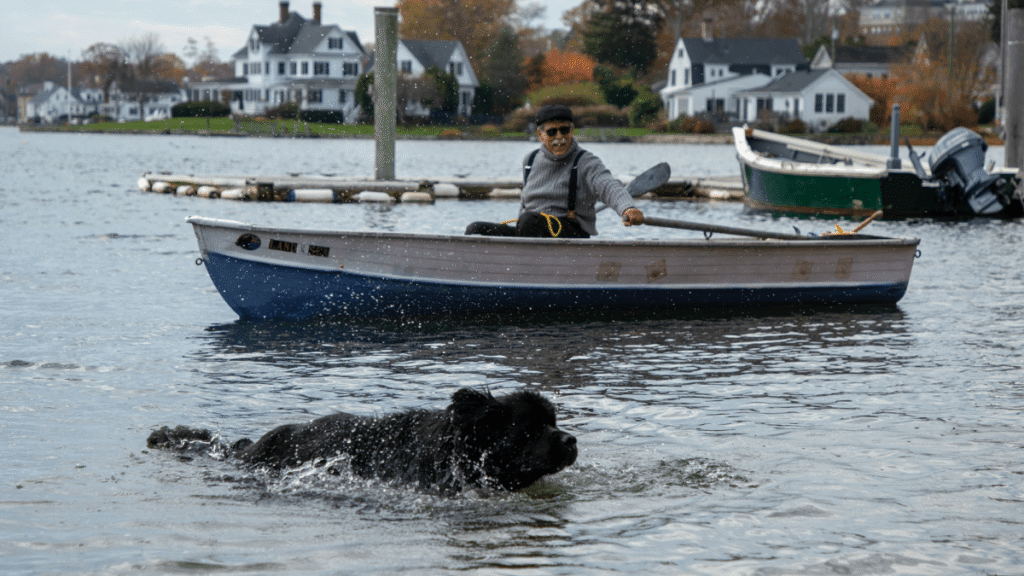It’s a dark and stormy night and you’ve suddenly found yourself swept off of your wooden vessel into the wild Atlantic Ocean. It’s 1893, so your woolen clothes are pulling you down to Davy Jones’ locker. What kind of dog would want to rescue you? Chances are, you’re not hoping for a bulldog or pug. You’d probably want a big, warm, and powerful canine. A dog like a Newfoundland.
Fast forward to 2025, specifically to Connecticut’s Mystic River, and a man in a rowboat is calling out to shore. “Come, Sasha! Come!” A large, fluffy, black dog then jumps from the sandy shore and into the brackish water. The Newfoundland grabs onto a rope, pulling the entire boat safely into shore in a demonstration of what these dogs have done for centuries.
Newfoundlands have a long history of water rescue, cart pulling, and even babysitting. Today, Sasha is one of the 17 Newfoundlands (or Newfies) working at the Mystic Seaport Museum. The 96-year-old living history museum is dedicated to preserving America’s maritime past, and several times a year, visitors get to see more than just rigging and sextants. They can watch Sasha and other Newfoundlands practice their water rescue and cart pulling skills so that they are not lost to time.
“One of the things that I love about our partnership with the Mystic Seaport Museum, is that the environment is exactly where a Newfoundland dog would have been,” Shelia Mallinson, president of the Land and Sea Newfoundland Training Group, tells Popular Science. “They would be working in that setting, they would have been helping on the boats. We’re working with them to really utilize those skills and keep them alive.”
Past meets present meets pooch
About two hours south of Boston, Massachusetts, the Mystic Seaport Museum is home to a recreated New England coastal village, a working shipyard, and over 500 historic watercraft including the 1841 whaleship Charles W. Morgan, America’s oldest commercial ship still in existence.
On select days, guests can watch Newfoundlands in action, practicing their water rescue and cart pulling skills through the recreated village, while learning about the dogs and their history from Newfoundland owners. It also gives visitors a chance to see this historic breed up close.
“There are always people who tell us that they came to the seaport simply to see the dogs,” Land and Sea Newfoundland Training Group member Deja Petsch tells Popular Science. “Which is funny to me, because I can always just pet my dog, but you have to remember that not everyone can have a dog like this right in their household.”
The Land & Sea Newfoundland Training Group is a group of Newfoundland dog enthusiasts who are dedicated to preserving the heritage of the breed. In addition to their demonstrations with Mystic Seaport Museum, they host other educational demonstration events like Christmas tree pulls. Importantly, the group also provides training and education for responsible dog ownership—whether your canine is a family dog or ship’s dog.

The original ship’s dog
Maritime history is full of true stories and tall tales of the Newfoundland’s deeds. During the Lewis and Clark expedition from 1804 to 1806 a black Newfoundland owned by Merryweather Lewis named Seaman helped hunt beavers, brought catches back from hunting parties, and allegedly caught a goat in the water. He also saved his human companions from charging bison on several occasions and alerted the party when bears were around along the Upper Missouri River in present-day Montana.
Another longstanding legend alleges that RMS Titanic First Mate William Murdoch smuggled his Newfoundland named Rigel aboard. However, that story was likely made up by a reporter. But even if a Newfoundland wasn’t onboard the Titanic, the dogs have certainly been a presence aboard numerous other ships and working in seaports.
“The Newfoundland is the original ship’s dog,” says Mallinson. “They were found on shipping vessels in the 19th century. They were utilized on the boats for bringing in fishing gear, bringing in fishing nets,” she explains. “They would be hitched to a cart so they could take the catch of the day to market. They also rescued people who had fallen overboard.”
When the catch of the day was ready to be hauled into town or firewood needed to be delivered, these able-bodied dogs could pull carts loaded with hundreds of pounds of goods. Some dogs in this modern training group have even pulled 15-foot-tall Christmas trees!

“Having a dog as your working draft animal had some advantages over more traditional draft animals for that time and place, namely a horse,” Land and Sea Newfoundland Training Group member Steve Petsch tells Popular Science. “Dogs are kind of more versatile. They’ll work for fish, whereas the horses are a little more fickle in that kind of an environment. And horses are probably a little more expensive to keep under those economic conditions.”
Horses require a more expensive diet of grass, hay, and oats, making their upkeep more expensive than a working dog.
“So not only in the water was their size an advantage, but also on land, both for not being too small, but not being so big and costly as a horse,” Steve says.
And their work did not stop at the end of the day. The true gentle giants were helpful at home, bringing in firewood, transporting milk or mail, and even watching over children. The protective and loving dog Nana in the novel Peter Pan was a Newfoundland.

Why the Newfoundland?
Newfies are considered working dogs, a group that also includes Bernese mountain dogs, Alaskan malamutes, and Saint Bernards. While it varies by breed, these dogs are generally capable of performing tasks that require a lot of physical strength.
“For water rescue, their [Newfoundlands’] double coat makes them suitable because it is composed of outer guard hairs that are relatively waterproof or water-resistant, and an undercoat that serves as an insulator,” Cornell University veterinarian Dr. Aly Cohen tells Popular Science. “The double coat helps them regulate their body temperature properly. In terms of personality, their gentle, calm, and confident temperament also makes them suitable for rescue work.”
Newfoundlands also have wide, webbed feet and a “long, straight, and strong tail,” according to Cohen. That tail and feet combo are like built-in paddles and a rudder, helping them swim effectively. Coupled with their size, a Newfoundland can weigh over 150 pounds, they are the type of dog that you’d definitely want coming to rescue you if you fell overboard.
“The Newfoundland was such a valued member of the team that they would make space for them [onboard],” says Deja.

When it comes to draft work—pulling carts full of firewood, milk, fish, and other important goods—sheer strengthened and well-muscled bodies come in handy. They also have a lower center of gravity than other dog breeds, which helps them pull those heavier loads. Combine that with their general demeanor and you have an animal fit for working with and for humans.
“Essentially, they really want to work with people,” says Deja. “They want to connect with humans. They want to have a job to do. They want to be a part of what you’re doing, and they don’t care what you’re doing.”

Preserving skills and trades
At Mystic Seaport Museum, the dogs get the chance to consistently practice these unique skills. Training any dog requires time, patience, and repetition in order to be Canine Good Citizens. This 10-skill test conducted by the American Kennel Club teaches good manners to dogs and responsible dog ownership to their owners at the same time.
Most of the dogs in the Land and Sea Newfoundland Training Group are not only certified in water rescue and as Canine Good Citizens, but are registered therapy dogs as well. With a dog the size of a Newfoundland, it’s crucial that both owner and dog are trained to keep everyone—both the canine and humans—safe.
“A male Newfoundland who could be 150 or 170 pounds can easily pull you all over the place, can pull you onto the ground,” says Deja. “We always try to be incredibly respectful of the fact that, yes, there are people who come to Mystic Seaport to see the dogs. But there are definitely people who come to Mystic Seaport who want to enjoy the seaport and don’t like dogs.”
However, good training and developing people skills does not mean strict or fierce training. “Newfoundlands, and probably more dogs than we recognize, are somewhat soft in their approach to training. They want it to be a partnership where they feel valued and rewarded,” Steve explains.

For example, instead of approaching something like pulling a cart of firewood as a boring task, it is portrayed and worked on as something fun to do together.
“I think our approach to training with the dogs really matches that natural part of them that is a partner that likes a sort of a softer, kinder training environment,” Steve says.
This type of training paired with a living history museum, where skilled interpreters work as blacksmiths, coopers, ship builders, and more, preserves a chapter of American maritime history that Newfoundlands played an important role in.
“Anything that has to do with history is important. Keeping it alive, whether it’s the ships and the buildings at the seaport or the people or the animals that would be there during that time, it all goes together,” says Mallinson. “It’s all an important part of our heritage and the dogs were a part of it, so it’s good to have them out there doing all of this.”

2025 Holiday Gift Guide


